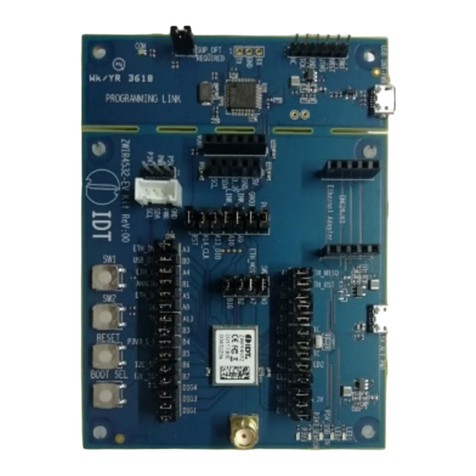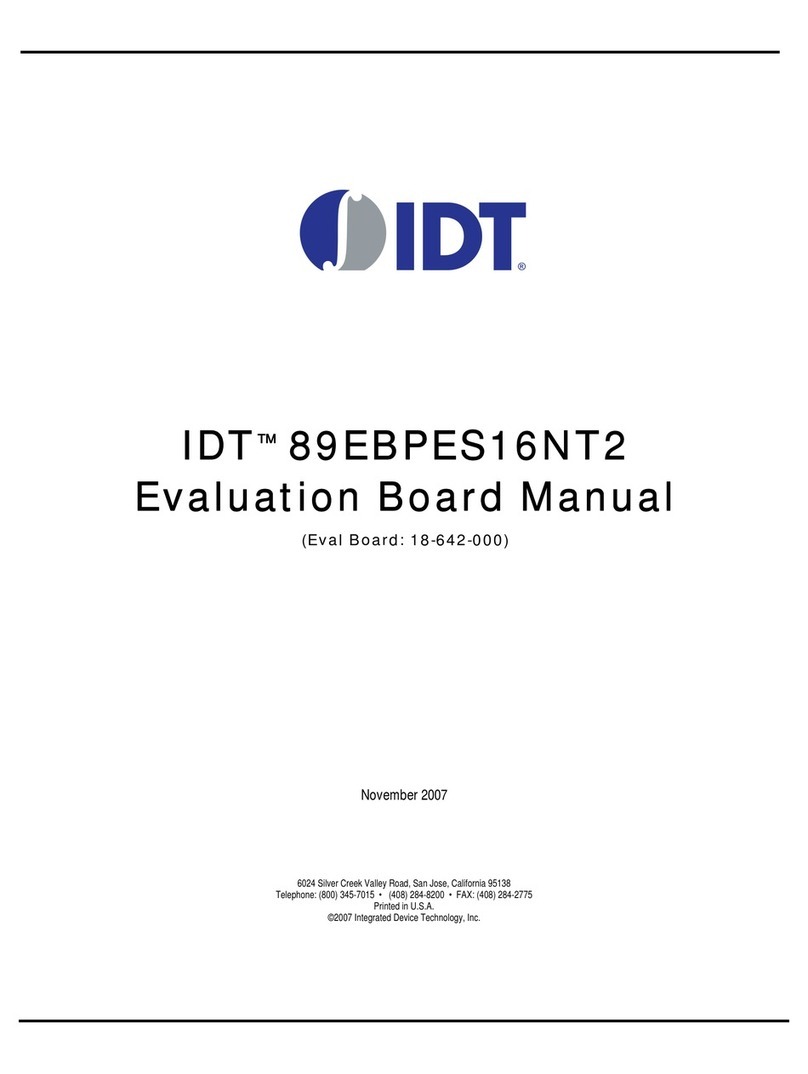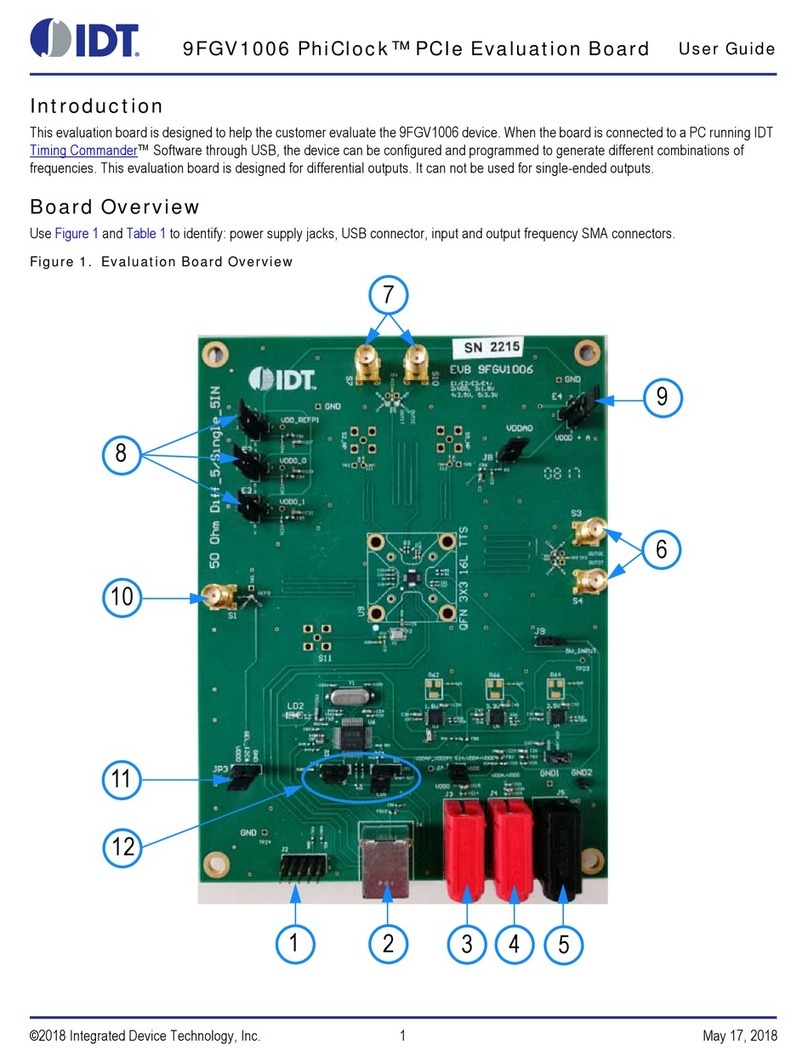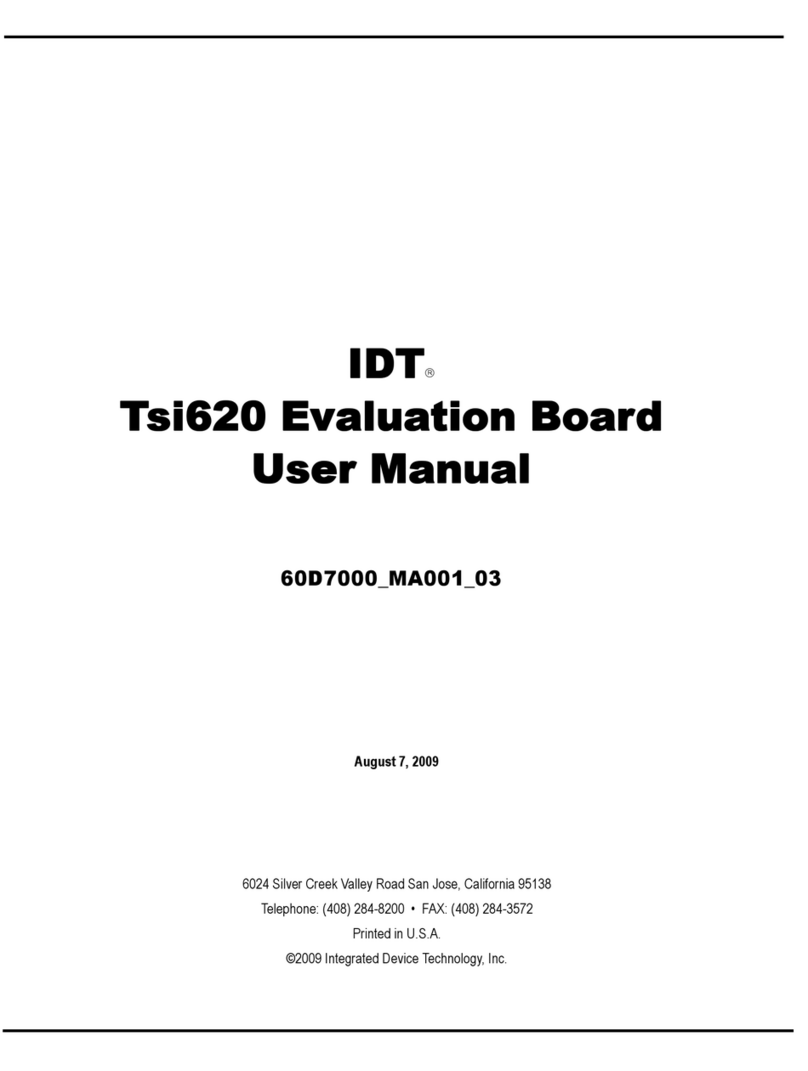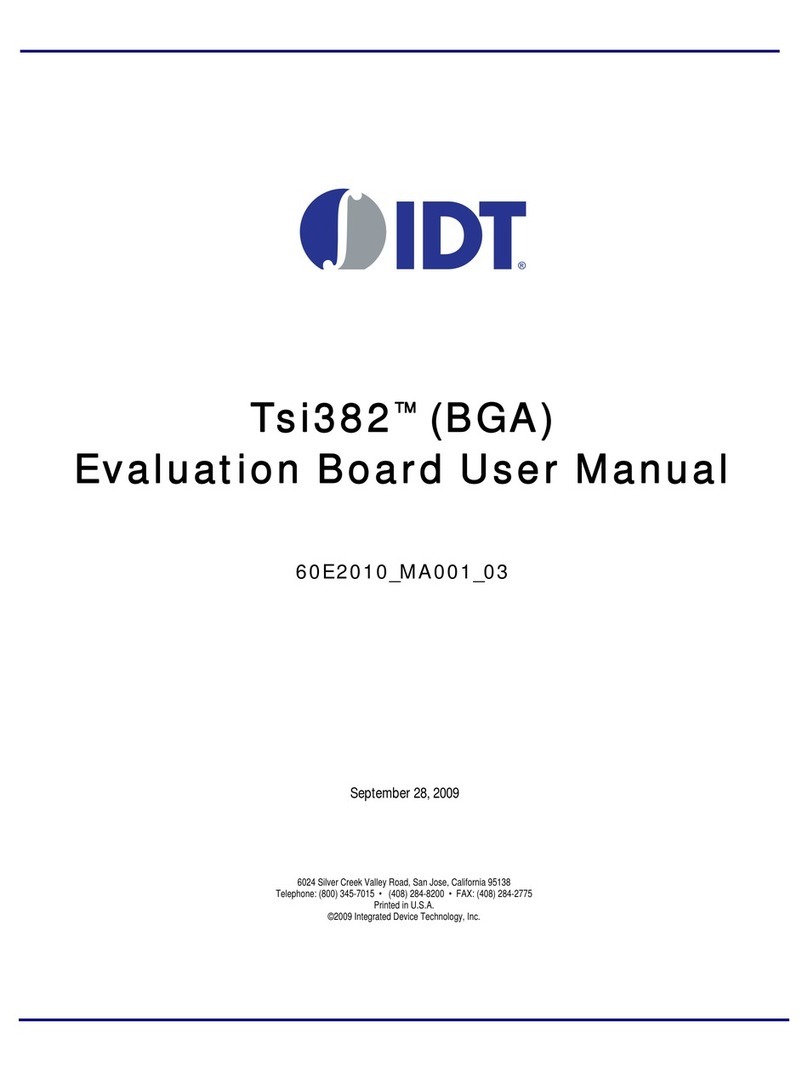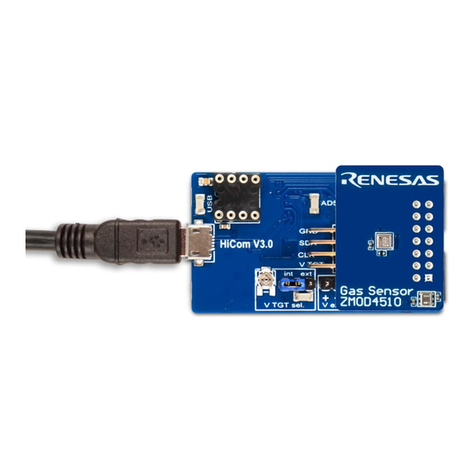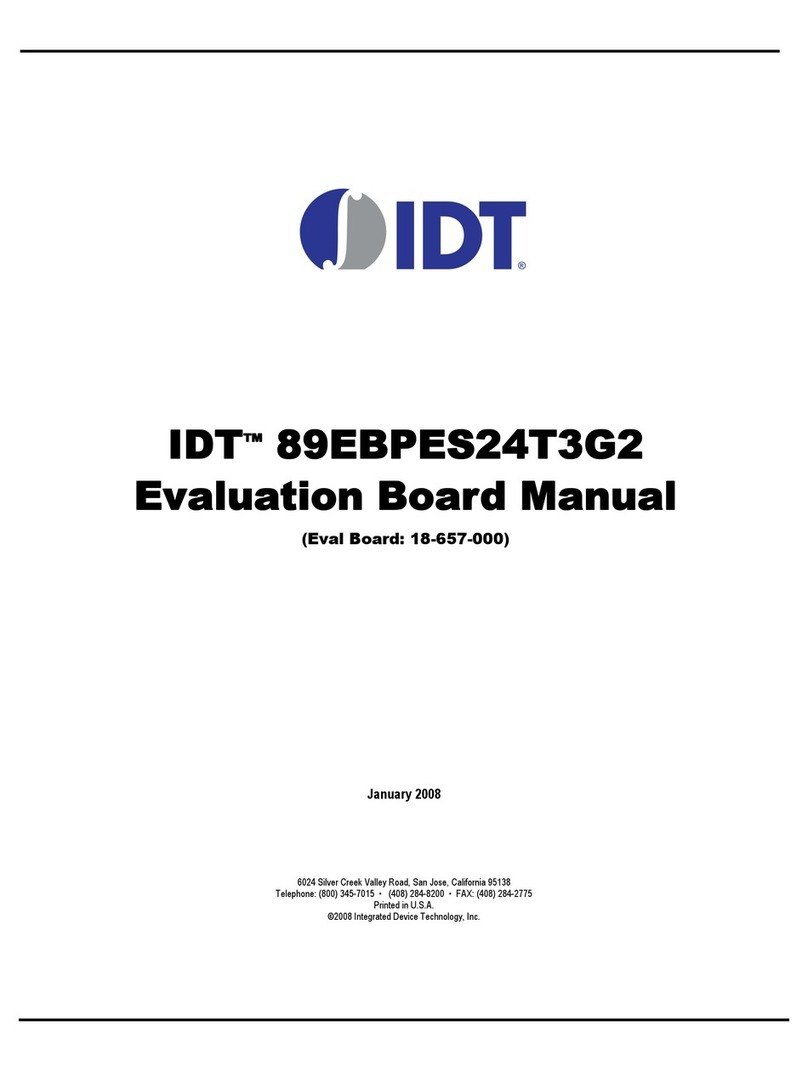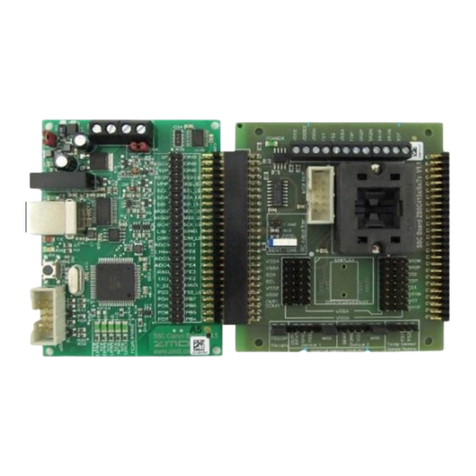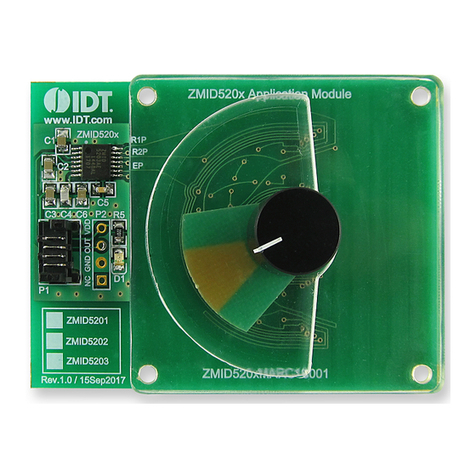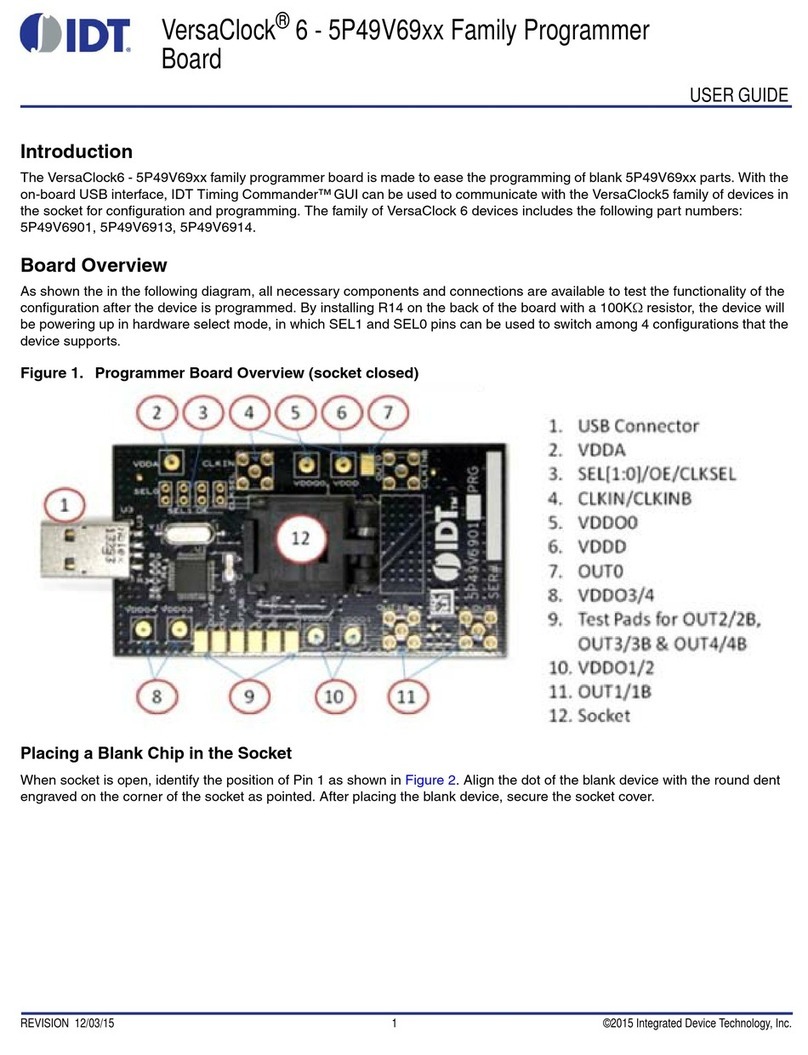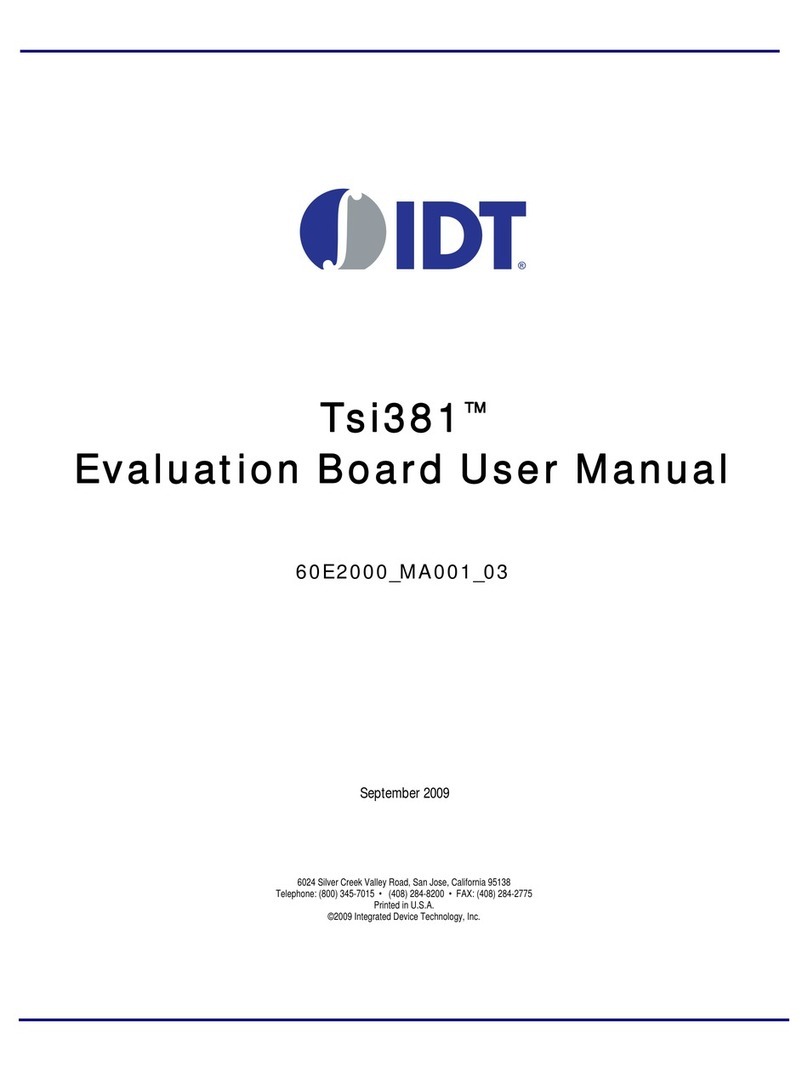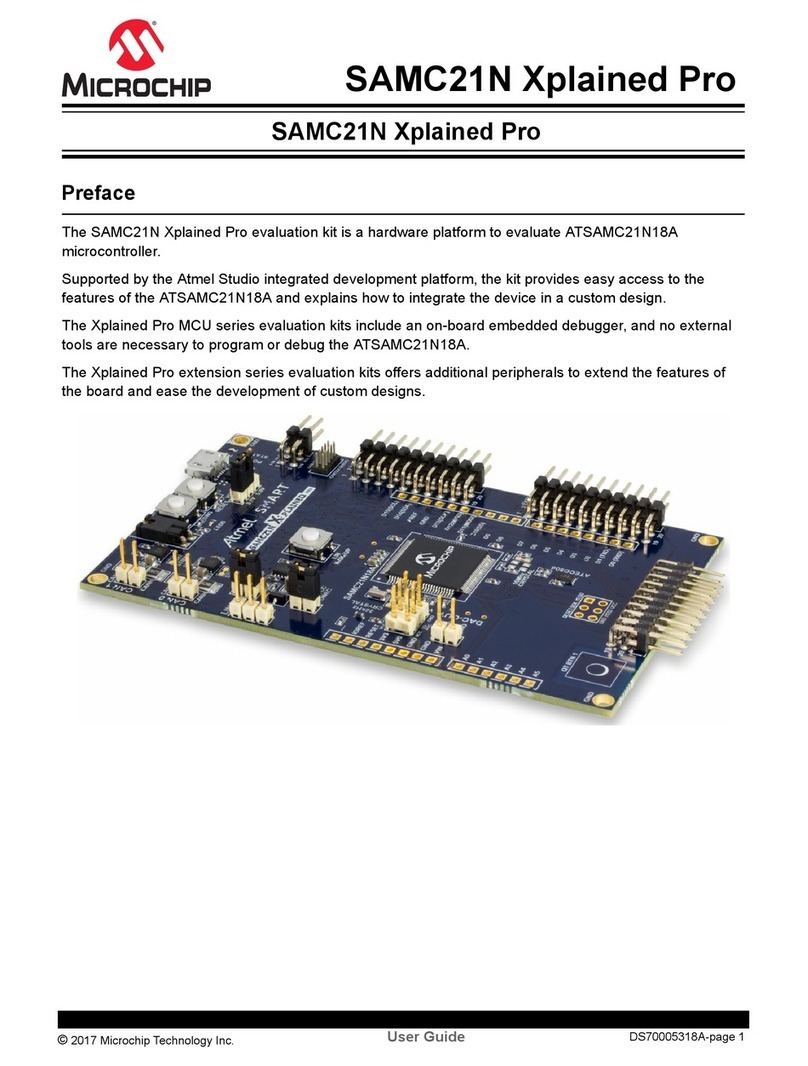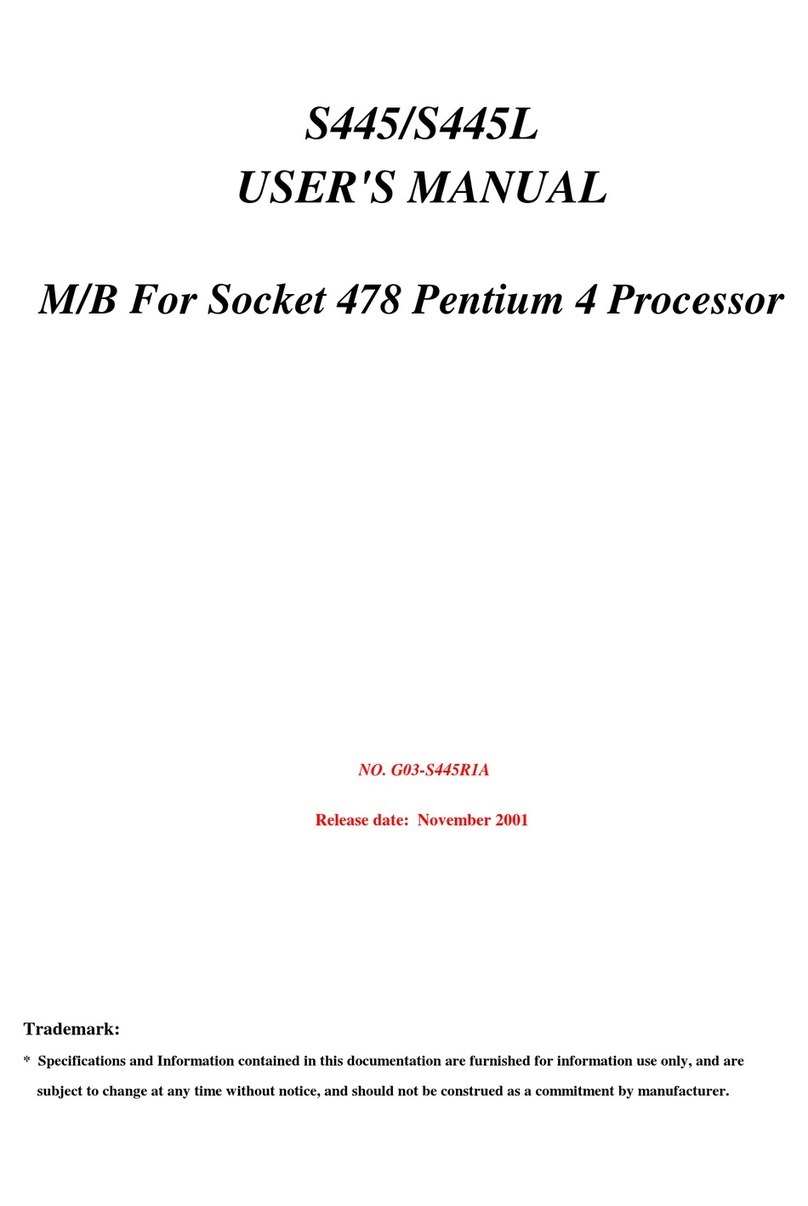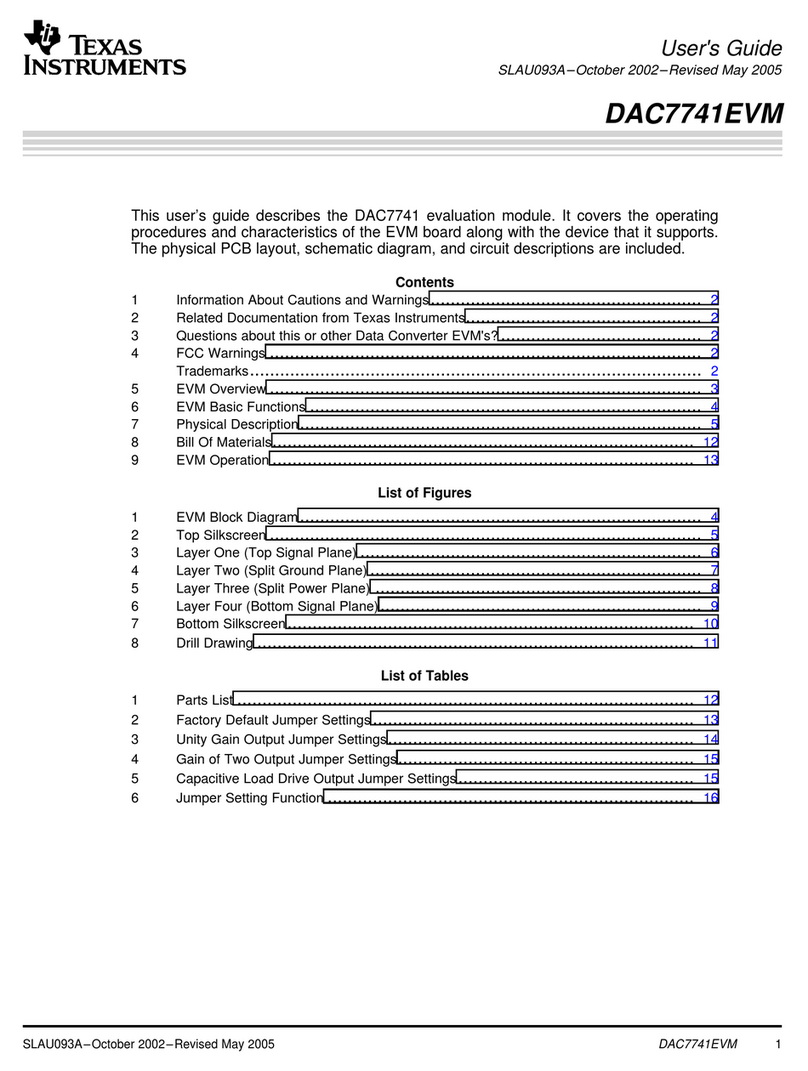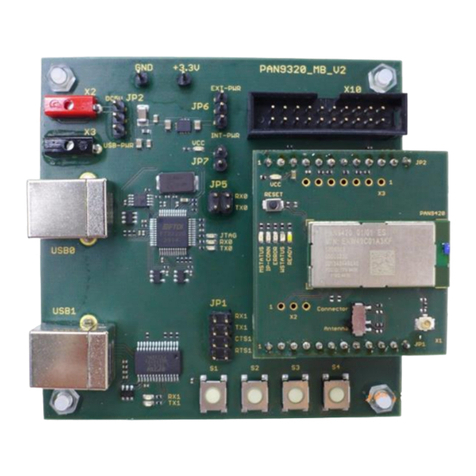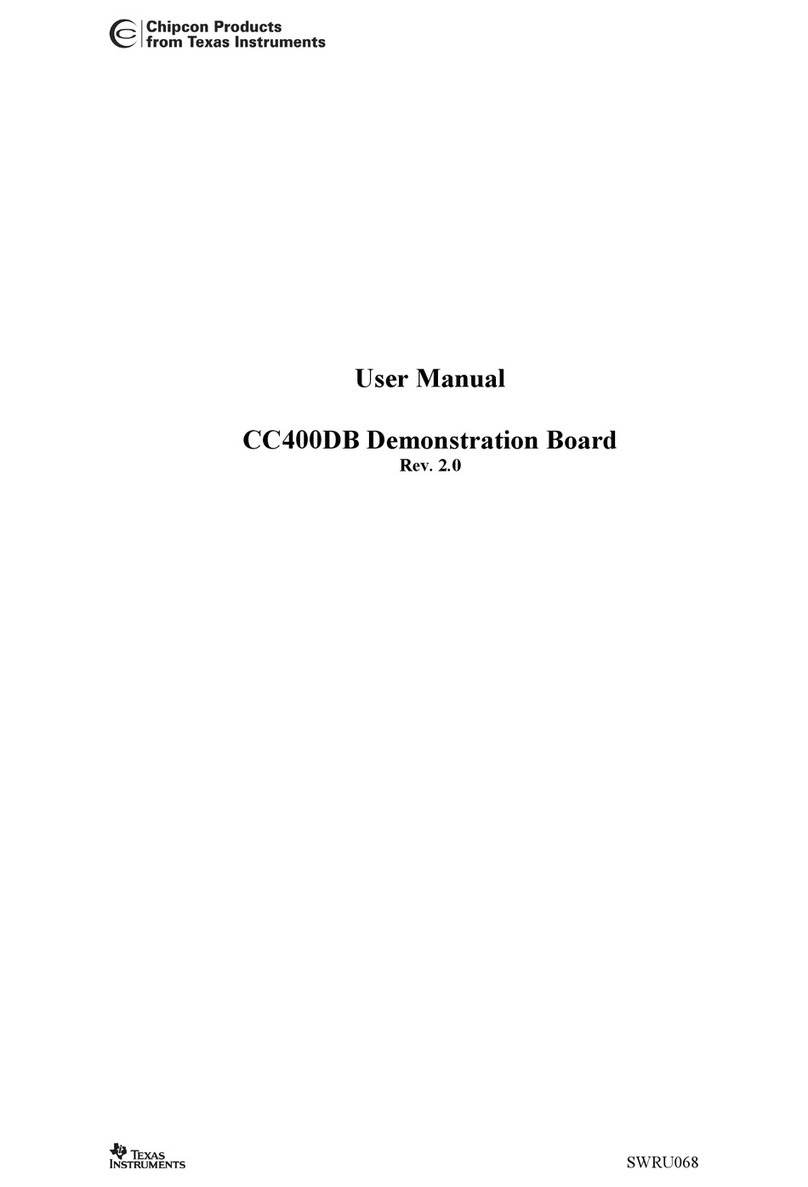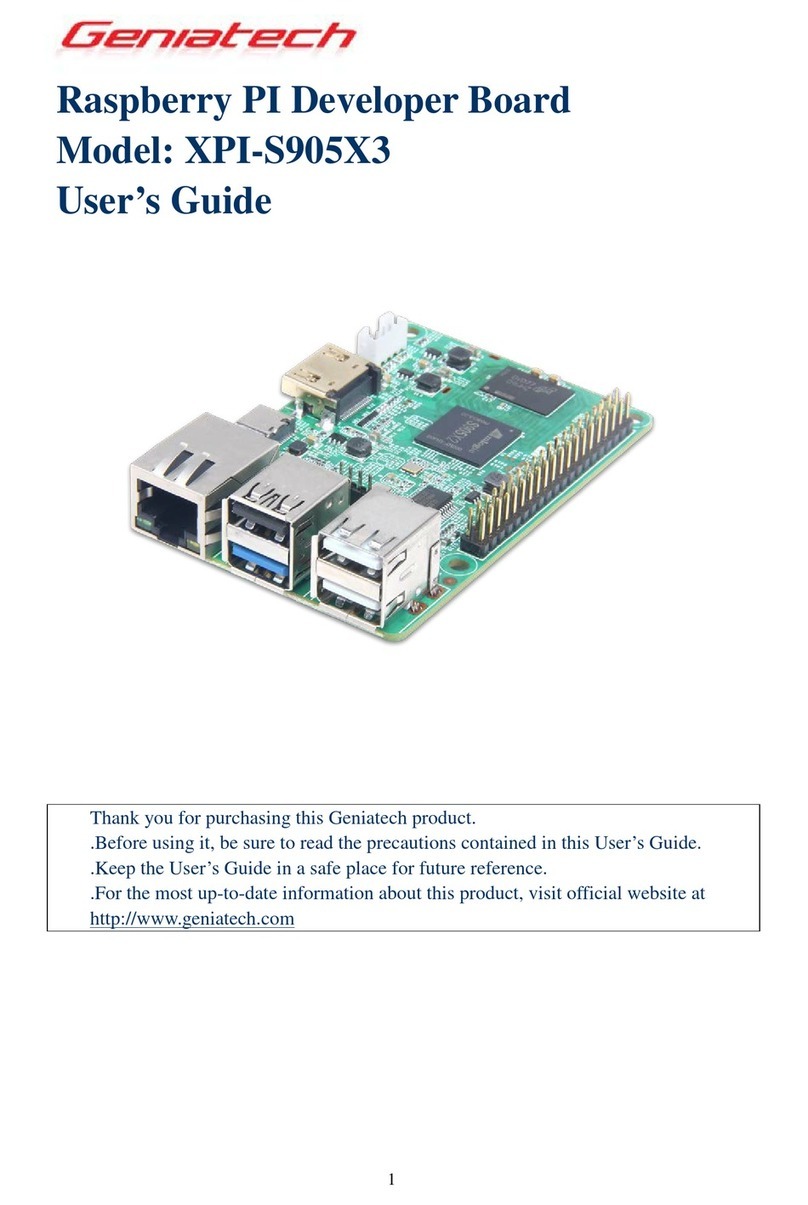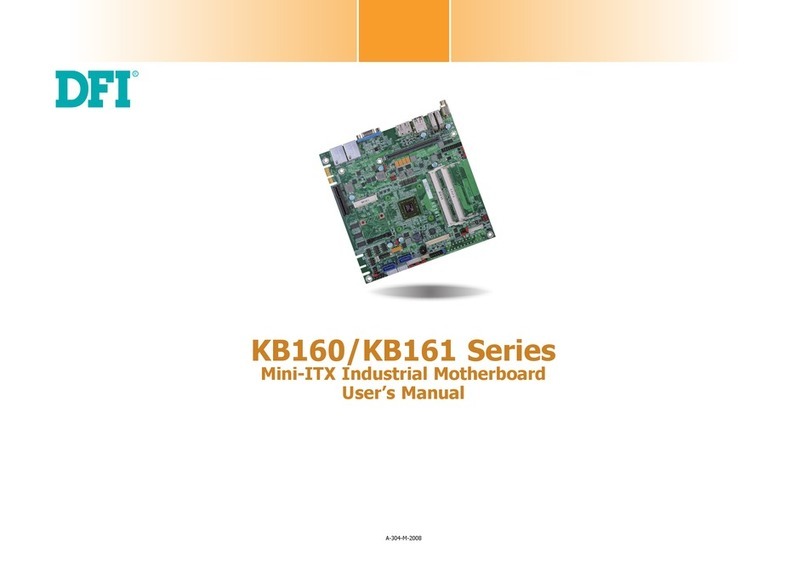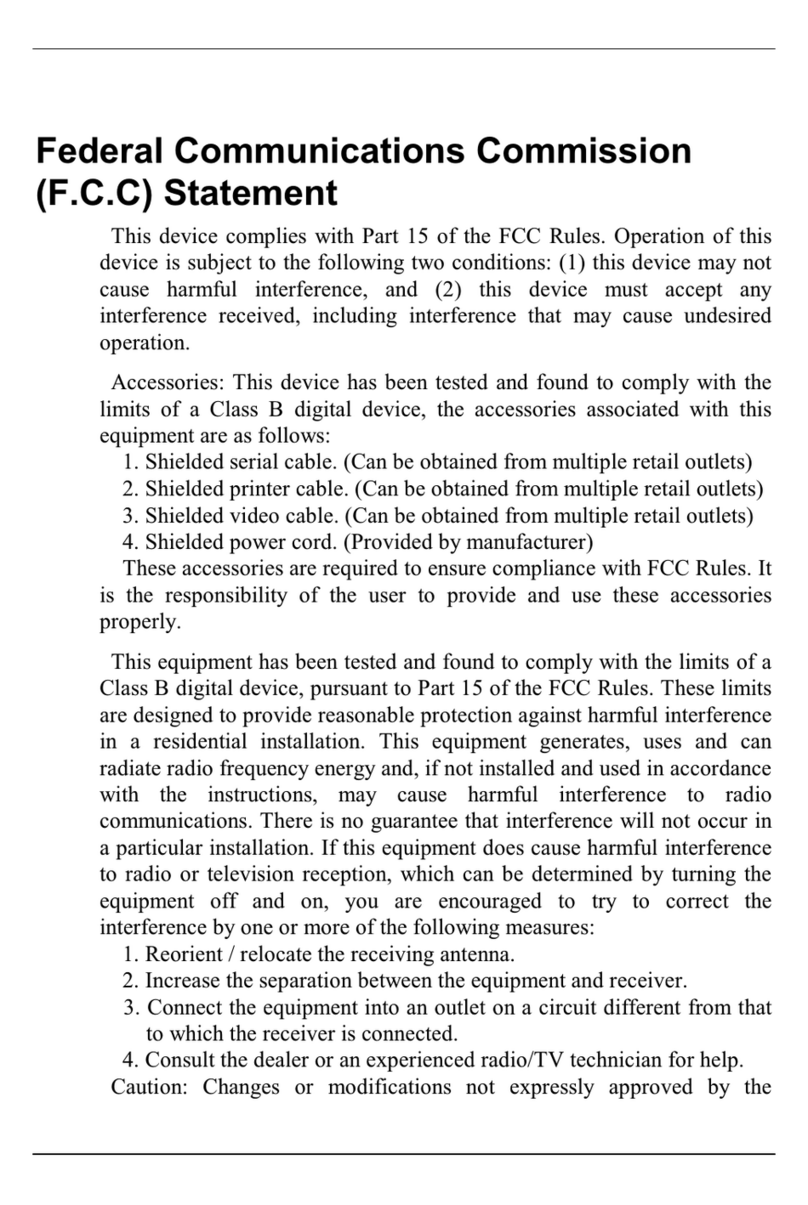IDT 8A 72QFN Series User manual

8A3xxxx 72QFN EVK User Manual
© 2019 Integrated Device Technology, Inc.
1
February 14, 2019
Description
The 8Axxxx 72QFN EVK is designed to help customers evaluate
IDT ClockMatrix devices. This document discusses the following
about the EVK:
Introduces the board and its power supply and jumper settings
Describes the input and output connectors for normal
operation
Explains how to bring up the board using the Timing
Commander software GUI
Discusses how to configure and program the board to
generate standard-compliant frequencies
Kit Contents
8A34xxx 72QFN Evaluation Board
USB Type A cable
Requirements
IDT Timing Commander Software Installed (available at
www.idt.com/timingcommander)
ClockMatrix GUI (available at www.idt.com/clockmatrix)
USB 2.0 or USB 3.0 interface
Windows XP SP3 or later
Processor: Minimum 1GHz
Memory: Minimum 512MB; recommended 1GB
Available disk space: Minimum 600MB (1.5GB 64-bit);
recommended 1GB (2GB 64-bit)
Network access during installation if the .NET framework is
not currently installed on the system
8A3xxxx 72QFN EVK Board

8A3xxxx 72QFN EVK User Manual
© 2019 Integrated Device Technology, Inc.
2
February 14, 2019
Important Notes
Disclaimer
Integrated Device Technology, Inc. and its affiliated companies (herein referred to as “IDT”) shall not be liable for any damages arising out of defects resulting from
(i) delivered hardware or software
(ii) non-observance of instructions contained in this manual and in any other documentation provided to user, or
(iii) misuse, abuse, use under abnormal conditions, or alteration by anyone other than IDT.
TO THE EXTENT PERMITTED BY LAW, IDT HEREBY EXPRESSLY DISCLAIMS AND USER EXPRESSLY WAIVES ANY AND ALL WARRANTIES, WHETHER
EXPRESS, IMPLIED, OR STATUTORY, INCLUDING, WITHOUT LIMITATION, IMPLIED WARRANTIES OF MERCHANTABILITY AND OF FITNESS FOR A
PARTICULAR PURPOSE, STATUTORY WARRANTY OF NON-INFRINGEMENT, AND ANY OTHER WARRANTY THAT MAY ARISE BY REASON OF USAGE
OF TRADE, CUSTOM, OR COURSE OF DEALING.
Important Equipment Warning: Ensure the correct connection of all cables. Supplying the board using the wrong
polarity could result in damage to the board and/or the equipment. Check that all jumpers have been removed from
the board before applying power.
Contents
1. Usage Guide.................................................................................................................................................................................................4
1.1 Board Overview...................................................................................................................................................................................4
1.2 Board Power Supply............................................................................................................................................................................5
1.3 Voltage Selection Jumpers..................................................................................................................................................................5
1.4 GPIO Switches, LEDs, and Test Points ..............................................................................................................................................6
1.5 USB Jack.............................................................................................................................................................................................7
1.6 I2C between FTDI, CM Device, and Onboard EEPROM .....................................................................................................................7
2. Working with Timing Commander™ for Programing/Configuration..............................................................................................................8
2.1 Default Operation ................................................................................................................................................................................8
2.2 Using Timing Commander to Control the Board..................................................................................................................................9
2.3 Output Terminations and Rework to Take 1PPS Input......................................................................................................................15
3. How to Upload Firmware to the RAM .........................................................................................................................................................16
4. Schematics.................................................................................................................................................................................................18
5. Ordering Information...................................................................................................................................................................................18
6. Revision History..........................................................................................................................................................................................18
!

8A3xxxx 72QFN EVK User Manual
© 2019 Integrated Device Technology, Inc.
3
February 14, 2019
List of Figures
Figure 1. Overview of 72QFN ClockMatrix Evaluation Board.............................................................................................................................4
Figure 2. Example of Voltage Jumpers...............................................................................................................................................................5
Figure 3. GPIO Setting and Status Display Area................................................................................................................................................7
Figure 4. Board Setting for Default Operation ....................................................................................................................................................8
Figure 5. Starting Up Timing Commander GUI...................................................................................................................................................9
Figure 6. Selecting 8A34001 using Personality File v4.6..................................................................................................................................10
Figure 7. Timing Commander GUI with a Settings File Opened.......................................................................................................................11
Figure 8. Setting I2C for Connecting the Board with GUI..................................................................................................................................12
Figure 9. A Green Band appears when a Valid Connection is Made................................................................................................................12
Figure 10. Firmware Version Mismatch Warning Message ................................................................................................................................13
Figure 11. Reading Firmware Version ................................................................................................................................................................13
Figure 12. Read Firmware Version of ClockMatrix Chip.....................................................................................................................................14
Figure 13. AC Coupling and Terminations for Input Clock..................................................................................................................................15
Figure 14. Configuring CLK0 as CMOS to Receive a 1PPS Input......................................................................................................................15
List of Tables
Table 1. GPIO Settings......................................................................................................................................................................................6
Table 2. EEPROM I2C Connections ..................................................................................................................................................................7

8A3xxxx 72QFN EVK User Manual
© 2019 Integrated Device Technology, Inc.
4
February 14, 2019
1. Usage Guide
1.1 Board Overview
The following diagram identifies various components of the board: input and output SMA connectors, power supply jacks, and some jumper
settings necessary for the board operations.
Figure 1. Overview of 72QFN ClockMatrix Evaluation Board
Detailed descriptions of the board are as follows:
Input SMA Connectors –There are five differential inputs labeled CLK0/nCLK0–CLK4/nCLK4. Each input clock can be configured
differentially (LVDS, PECL 2.5V, and PECL 3.3V) or in single-ended format (CMOS).
Output SMA Connectors –There are 12 outputs labeled as Q0/nQ0–Q11/nQ11. Each output clock can be configured differentially (LVDS,
LVPECL, or user-defined amplitude) or in single-ended format (LVCMOS –in-phase or out-of-phase).
GPIO switch, LEDs, and test points –There are seven GPIOs available. Each GPIO can be set a “low” or “high” level (if input) or
displayed with an LED (if output). Some GPIOs are used to set the chip in a certain working condition on power-up. For more information,
see GPIO Switches, LEDs, and Test Points.
USB connector –A USB mini connector connects the evaluation board to a PC for GUI communications. No power is drawn from the USB
connector other than to power the FTDI USB chip.

8A3xxxx 72QFN EVK User Manual
© 2019 Integrated Device Technology, Inc.
5
February 14, 2019
VDDQx voltage selection jumpers –Each output voltage can be individually supplied with 1.8V, 2.5V, or 3.3V. These jumpers are used to
select the voltage for the output voltages.
Reset button –A small button is used to reset the board.
OSCI Input connector –An SMA connector, J45, can optionally supply a clock signal to overdrive the crystal.
Optional OCXO/TCXO Reference –An OCXO/TCXO footprint, is output at J82. It can be connected to J46 (below) as the reference for
the System DPLL.
SysDPLL Input –An SMA connector, J46, is provided to supply a local OCXO/TCXO reference as an optional reference for the System
DPLL.
Crystal –A crystal of various frequencies must be present for board operations. A 3225 footprint is provided for SMT crystals. For easy
plug-in of a canned crystal, two through holes are also available.
EEPROM –An SO-8 socket is provided to hold an EEPROM device of compatible package. An EEROM is used to store firmware and
customer configuration data, if needed.
1.2 Board Power Supply
The board uses a single +5V supply for its power supplies. When running the board, please set the bench power supply at 5V/2A. The red jack
(J1) is positive; the black jack (J2) is the ground.
Multiple LDOs are used to generate 3.3V, 2.5V, and 1.8V from the +5V supply.
1.3 Voltage Selection Jumpers
There are eight headers/jumpers to select different voltages for different functional blocks of the chip. Each header has pin 1 and 3 labeled in
silkscreen –jumping pin 1 and pin 2 will select 3.3V; jumping pin 2 and pin 3 will select 2.5V; no jumper will have 1.8V.
Please see the following example for JP4 and JP9 –JP4 will select 2.5V; JP9 will select 3.3V.
Figure 2. Example of Voltage Jumpers

8A3xxxx 72QFN EVK User Manual
© 2019 Integrated Device Technology, Inc.
6
February 14, 2019
The following list shows which head/jumper is used to select what voltage:
JP1 –VDDD
JP2 –VDDA
JP3 –VCC_GPIO_DC
JP4 –VDDO_Q8_3_5
JP5 –VDDO_Q2_4_11
JP6 –VDDO_1_10_7
JP7 –VDD_CLK0
JP9 –VDDO_Q0_9_6
Important Equipment Warning: VDD_FOD voltage is selected by resistors R908 and R909. In order to prevent
damage to the device, both R908 and R909 should not be stuffed, in which case VDD_FOD = 1.8V.
1.4 GPIO Switches, LEDs, and Test Points
An 8-bit dip switch sets the logic levels for seven GPIOs (GPIO0-5 and GPIO9). The following table shows the GPIO levels for each setting and
the corresponding LED state.
Table 1. GPIO Settings
Dip Switch Position
GPIO Logic Level
LED
Left
Low
On
Center
High if GPIO is configured as Input
High or Low according to the GPIO output setting
High if GPIO is configured as Input
High or Low according to the GPIO output setting
Right
High
Off
Please see the picture and labels in Figure 3.
When the GPIOs are configured as outputs (such as User-Controlled or LOL indicator), the dip switch for the corresponding GPIO should be
placed in the center position. The LED will indicate the state of the GPIO.
!

8A3xxxx 72QFN EVK User Manual
© 2019 Integrated Device Technology, Inc.
7
February 14, 2019
Figure 3. GPIO Setting and Status Display Area
1.5 USB Jack
The board has a USB mini-connector. The other end of the USB cable is a USB Type A connector going to a PC.
1.6 I2C between FTDI, CM Device, and Onboard EEPROM
One of the major differences between the 72QFN and 144BGA144 chips is that there is only one serial bus on the 72QFN chip. The I2C bus
between the FTDI chip and CM chip is the same bus between the CM chip and the onboard EEPROM. The onboard EEPROM is used to store
device firmware and/or customer’s configuration data. JP12 and JP13 must be jumped between pin 1 and 2 to enable the I2C connections.
Table 2. EEPROM I2C Connections
JP12/JP13
JP12/JP13
Jumper Position
Pin 1 and 2
Pin 2 and 3
EEPROM I2C Path
FDTI and CM Chip;
CM Chip and EEPROM
N/A

8A3xxxx 72QFN EVK User Manual
© 2019 Integrated Device Technology, Inc.
8
February 14, 2019
2. Working with Timing Commander™for Programing/Configuration
The following sections are best cross-referenced with the ClockMatrix GUI Step-by-Step User Guide which is available on www.idt.com.
2.1 Default Operation
The board can operate off an EEPROM that has stored all information including firmware and a default configuration data. A default operation
provides a sanity check on the board before running the board through the IDT Timing Commander. Please set the board in the following default
conditions (see Figure 4 for jumper and switch positions).
Set all the GPIOs to the center position. This will ensure that GPIO9 is high and that the serial port is configured for I2C 1-byte
addressing.
VDDA = 3.3V, VDD_ FOD = 1.8V, and VDDO_Qx = 3.3V
Crystal frequency = 50MHz
CLK0 = 25MHz
FTDI, CM device, and EEPROM share the same I2C bus by jumping Pin 1 and 2 of JP12 and JP13
With the above default conditions ready, connect the board to the PC using a USB type A to USB mini cable, and power up the board using a
single +5V supply. On power-up, the ClockMatrix chip will read its firmware and configuration data from EEPROM and update all registers.
When this process is completed, the following frequencies are available:
Q0 = 122.88MHz
Q1 = 122.88MHz
Figure 4. Board Setting for Default Operation
Important Equipment Warning: In order to set GPIO9 to “High”, the switch for GPIO9 must be set either to the “+”
(high) position or the center position.
!

8A3xxxx 72QFN EVK User Manual
© 2019 Integrated Device Technology, Inc.
9
February 14, 2019
2.2 Using Timing Commander to Control the Board
Once the default operation is successful, complete the following steps to configure and program the ClockMatrix device per your specific
application requirements using Timing Commander GUI tools:
1. Power up the board and set the main serial port in I2C mode by GPIO9 = “high”. Connect the board to the PC.
2. Start the Timing Commander software. You will see options of “New Setting File” and “Open Setting file”. For a new configuration, select
“New Setting File”.
Figure 5. Starting Up Timing Commander GUI

8A3xxxx 72QFN EVK User Manual
© 2019 Integrated Device Technology, Inc.
10
February 14, 2019
3. After selecting “New Settings File”, a device selection window will pop up. In the window, choose the intended device in the list (in this
example, 8A34001 is selected). Click the button at the lower right corner of the window (red circle) to browse and select the correct
personality file (in this example, personality v4.6 is selected). Click OK.
Figure 6. Selecting 8A34001 using Personality File v4.6

8A3xxxx 72QFN EVK User Manual
© 2019 Integrated Device Technology, Inc.
11
February 14, 2019
4. The GUI window with the 8A34001 block diagram will open for configurations; or if “Open Settings File” is selected in Step 3, you will be
prompted to browse and select an existing .tcs file and the personality file. When the configuration file is open, all configured values will be
displayed (see Figure 7).
Figure 7. Timing Commander GUI with a Settings File Opened

8A3xxxx 72QFN EVK User Manual
© 2019 Integrated Device Technology, Inc.
12
February 14, 2019
5. In order to connect the board with Timing Commander (PC), click the button (red circle) at the up-right corner of the GUI to set up the
communication protocols (see Figure 7).
After I2C and one-byte addressing are selected, click OK to close the window.
Figure 8. Setting I2C for Connecting the Board with GUI
6. Click on the chip symbol at the upper-right corner to initiate the connection. The connection is valid when a green band appears at the
upper-right corner of the window, as shown below.
Figure 9. A Green Band appears when a Valid Connection is Made

8A3xxxx 72QFN EVK User Manual
© 2019 Integrated Device Technology, Inc.
13
February 14, 2019
7. If ClockMatrix chip’s firmware, or firmware loaded from EEPROM, has a different version from that in the Personality file, a firmware version
mismatch warning message will appear. Click “Close” button to close the message window and a connection is made.
Figure 10. Firmware Version Mismatch Warning Message
8. Once the connection is made, the firmware version can be read within the GUI. Click the “Firmware Utility” button to bring up the Firmware
Utility window, as shown below.
Figure 11. Reading Firmware Version

8A3xxxx 72QFN EVK User Manual
© 2019 Integrated Device Technology, Inc.
14
February 14, 2019
9. Within the Firmware Utility window, click the “Get Firmware Version” button to read the firmware version.
Figure 12. Read Firmware Version of ClockMatrix Chip
10. In the case where the firmware version mismatches each other, a firmware upgrade is necessary to update the chip’s firmware. To do so,
complete the steps in How to Upload Firmware (see Section 3) to update the chip’s firmware.

8A3xxxx 72QFN EVK User Manual
© 2019 Integrated Device Technology, Inc.
15
February 14, 2019
2.3 Output Terminations and Rework to Take 1PPS Input
All outputs are terminated with a 100Ωresistor across the output pair. This is the recommended termination regardless of the Voffset and
Vswing settings. Since the outputs are DC-coupled, they will support a 1PPS output without any need for rework.
Important Equipment Warning: When connecting the outputs to measurement equipment, use a DC-block to ensure
that the output operates at its intended Voffset. Otherwise, the equipment may load the output down and cause degraded
performance.
The following rework must be implemented in order to support a 1PPS input clock. All input clocks for this board are ac-coupled and terminated
as in the following figure.
Figure 13. AC Coupling and Terminations for Input Clock
For a 1PPS input, a single-ended input with DC-coupling is recommended. As such, the populated AC-coupling capacitor must be removed
and the input must be configured as LVCMOS, not differential.
1. In Figure 13, to make CLK0 supportive of 1PPS input, first configure CLK0 as LVCMOS in Timing Commander (see Figure 14).
Figure 14. Configuring CLK0 as CMOS to Receive a 1PPS Input
2. Once in LVCMOS mode, CLK0_P and CLK0_N will be two separate LVCMOS inputs instead of a differential pair. To make CLK0_P receive
a 1PPS input, replace C881 with a 0Ωresistor; and at the same time, remove R765 and R770.
!

8A3xxxx 72QFN EVK User Manual
© 2019 Integrated Device Technology, Inc.
16
February 14, 2019
3. How to Upload Firmware to the RAM
1. Connect to the EVK board.
2. Power up the board with no EEPROM present. This ensures the firmware is 4.0.2.7017, as displayed in the figure.
3. The GUI will indicate that the firmware on the chip does not match the GUI firmware. Press “Close”.
4. Open the “Firmware Utility” window by clicking on the button as follows.
5. Update the Firmware first. Press “Update RAM to Current FW Only”.
6. In the next window, press “Yes” and wait around 3-4 minutes.

8A3xxxx 72QFN EVK User Manual
© 2019 Integrated Device Technology, Inc.
17
February 14, 2019
7. Once the firmware is updated, the following window will indicate a successful update. Click “Close”.
8. Press “Get Firmware Version” to verify that the RAM was updated correctly, then click “Close”.

8A3xxxx 72QFN EVK User Manual
© 2019 Integrated Device Technology, Inc.
18
February 14, 2019
4. Schematics
Please see the schematics located at the end of this document.
5. Ordering Information
Orderable Part Number
Description
8A34044-EVK
8A3xxxx 72QFN Evaluation Kit
6. Revision History
Revision Date
Description of Change
February 14, 2019
Initial release.
Corporate Headquarters
6024 Silver Creek Valley Road
San Jose, CA 95138
www.IDT.com
Sales
1-800-345-7015 or 408-284-8200
Fax: 408-284-2775
www.IDT.com/go/sales
Tech Support
www.IDT.com/go/support
DISCLAIMER Integrated Device Technology, Inc. (IDT) and its affiliated companies (herein referred to as “IDT”) reserve the ri ght to modify the products and/or specifications described herein at any time,
without notice, at IDT's sole discretion. Performance specifications and operating parameters of the described products are determine d in an independent state and are not guaranteed to perform the same
way when installed in customer products. The information contained herein is provided without representation or warranty of any kind, whether express or implied, including, but not limite d to, the suitability
of IDT's products for any particular purpose, an implied warranty of merchantability, or non -infringement of the intellectual property rights of others. This document is presented only as a guide and does not
convey any license under intellectual property rights of IDT or any third parties.
IDT's products are not intended for use in applications involving extreme environmental conditions or in life support systems or similar devices where the failure or malfunction of an IDT pro duct can be
reasonably expected to significantly affect the health or safety of users. Anyone using an IDT product in such a manner does so at their own risk, absent an express, written agreement by IDT.
Integrated Device Technology, IDT and the IDT logo are trademarks or registered trademarks of IDT and its subsidiaries in the United States and other countries. Other trademarks used herein are the
property of IDT or their respective third party owners. For datasheet type definitions and a glossary of common terms, visit www.idt.com/go/glossary. All contents of this document are copyright of Integrated
Device Technology, Inc. All rights reserved.

5
5
4
4
3
3
2
2
1
1
D D
C C
B B
A A
OF
PROJECT NAME
DRAWN
CHECK
DESIGN TITLE
DRAWING NUMBER REVISION
RELEASE DATE SHEET
SUBTITLE
1.2SK-10280-01
IDT8A34001
91
Fidus Systems
375 Terry Fox Drive, Ottawa, ON K2K 0J8
Indira3
DB
DB
DB
27 October 2016
Block Diagram
OF
PROJECT NAME
DRAWN
CHECK
DESIGN TITLE
DRAWING NUMBER REVISION
RELEASE DATE SHEET
SUBTITLE
1.2SK-10280-01
IDT8A34001
91
Fidus Systems
375 Terry Fox Drive, Ottawa, ON K2K 0J8
Indira3
DB
DB
DB
27 October 2016
Block Diagram
OF
PROJECT NAME
DRAWN
CHECK
DESIGN TITLE
DRAWING NUMBER REVISION
RELEASE DATE SHEET
SUBTITLE
1.2SK-10280-01
IDT8A34001
91
Fidus Systems
375 Terry Fox Drive, Ottawa, ON K2K 0J8
Indira3
DB
DB
DB
27 October 2016
Block Diagram

5
5
4
4
3
3
2
2
1
1
D D
C C
B B
A A
SILKSCRN:
XO_DPLL
Maximum voltage on pin 7 = 1.8V
Place close to ClockMatrix
VDDO_Q0
VDDO_Q1
VDDO_Q2
VDDO_Q3
VDDO_Q4
VDDO_Q5
VDDO_Q6
VDDO_Q7
VDDO_Q8
VDDO_Q9
VDDO_Q10
VDDO_Q11
VDD_FOD_0
VDD_FOD_2
VDD_FOD_5
VDDA_0
VDDA_1
VDD_FOD_0
VDD_CLK0_0
VDDD VDDD_0
VDD_FOD
CLK_Q0_P 8
CLK_Q0_N 8
CLK_Q1_P 8
CLK_Q1_N 8
CLK_Q2_P 8
CLK_Q2_N 8
CLK_Q3_P 8
CLK_Q3_N 8
CLK_Q4_P 8
CLK_Q4_N 8
CLK_Q5_P 8
CLK_Q5_N 8
CLK_Q6_P 8
CLK_Q6_N 8
CLK_Q7_P 8
CLK_Q7_N 8
CLK_Q8_P 8
CLK_Q8_N 8
CLK_Q9_P 8
CLK_Q9_N 8
CLK_Q10_P 8
CLK_Q10_N 8
CLK_Q11_P 8
CLK_Q11_N 8
GPIO3 5
GPIO9 5
GPIO1 5
GPIO2 5
GPIO4 5
GPIO5 5
GPIO0 5
CLK_CLK0_P
CLK_CLK0_N
CLK_CLK1_P
CLK_CLK1_N
CLK_CLK2_P
CLK_CLK2_N
CLK_CLK3_P
CLK_CLK3_N
CLK_CLK4_P
CLK_CLK4_N
OSCO
OSCI
PLL_I2C_SCL_SCLK
PLL_I2C_SDA_SDIO
PLL_I2C_SDA_SDI
PLL_I2C_SDA_CSN
JTAG_SEL
TST_CHIP_RST_N_OD
Title
Size Document Number Rev
Date: Sheet of
<Doc> <RevCode>
<Title>
C
1 1Monday, May 21, 2018
Title
Size Document Number Rev
Date: Sheet of
<Doc> <RevCode>
<Title>
C
1 1Monday, May 21, 2018
Title
Size Document Number Rev
Date: Sheet of
<Doc> <RevCode>
<Title>
C
1 1Monday, May 21, 2018
R3920
C418 2200pF
C694 0.1uF
U409
IDT8A35018
OSCO
1
OSCI
2
VDDA_PDCP_XTAL
3
VDDA_FB
4
nMR
5
VDD_CLK
6
XO_DPLL
7
CLK0
8
nCLK0
9
CLK1
10
nCLK1
11
CLK2
12
nCLK2
13
CLK3
14
nCLK3
15
VDD_DIG
16
CLK4
17
nCLK4
18
SCLK
19
SDIO
20
SDI_A1
21
CS_A0
22
FILTER
23
VDDA_LC_BG
24
nTEST
25
GPIO3
26
nQ11
27
Q11
28
VDDO_Q11
29
VDD_DIA_FOD_B
30
VDDO_Q7
31
Q7
32
nQ7
33
GPIO9
34
nQ6
35
Q6
36
VDDO_Q6 37
VDDO_Q5 38
Q5 39
nQ5 40
VDDO_Q4 41
Q4 42
nQ4 43
VDDO_Q10 44
Q10 45
nQ10 46
GPIO2 47
VDD_GPIO_FOD 48
GPIO1 49
nQ9 50
Q9 51
VDDO_Q9 52
nQ3 53
Q3 54
VDDO_Q3 55
GPIO5 56
nQ2 57
Q2 58
VDDO_Q2 59
VDDO_Q1 60
Q1 61
nQ1 62
GPIO4 63
nQ0 64
Q0 65
VDDO_Q0 66
VDD_DIA_FOD_A
67
VDDO_Q8 68
Q8 69
nQ8 70
GPIO0 71
cREG_XTAL 72
EPAD
73
R934 0
C695 0.1uF
R910 2.67kDNS
C871 0.1uF
R456
0
R467 2.67kDNS
C762 0.1uF
DNS
C761 10uF
R466 49.9
DNS
C763 0.1uF
DNS
C692 10uF
RK19-03-13
J46
5-1814832-1
C693 0.1uF
OSCI
OSCO
This manual suits for next models
1
Table of contents
Other IDT Motherboard manuals
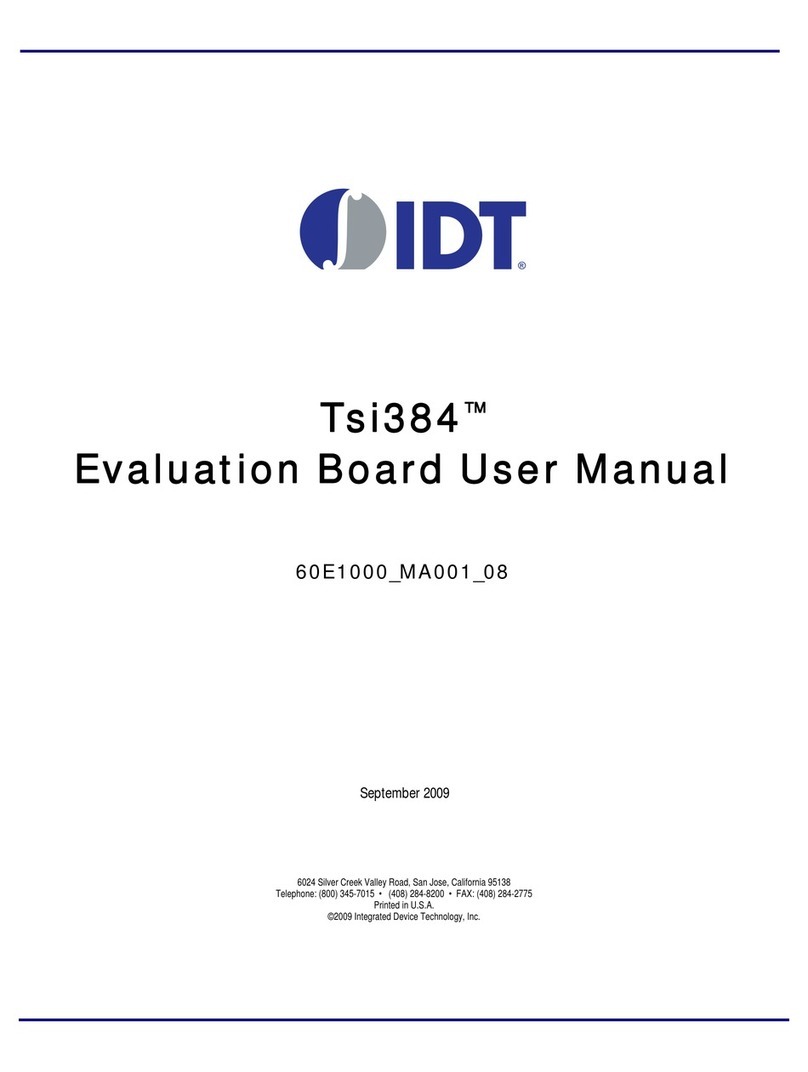
IDT
IDT Tsi84 User manual

IDT
IDT EVK-UFT285-6-7 User manual
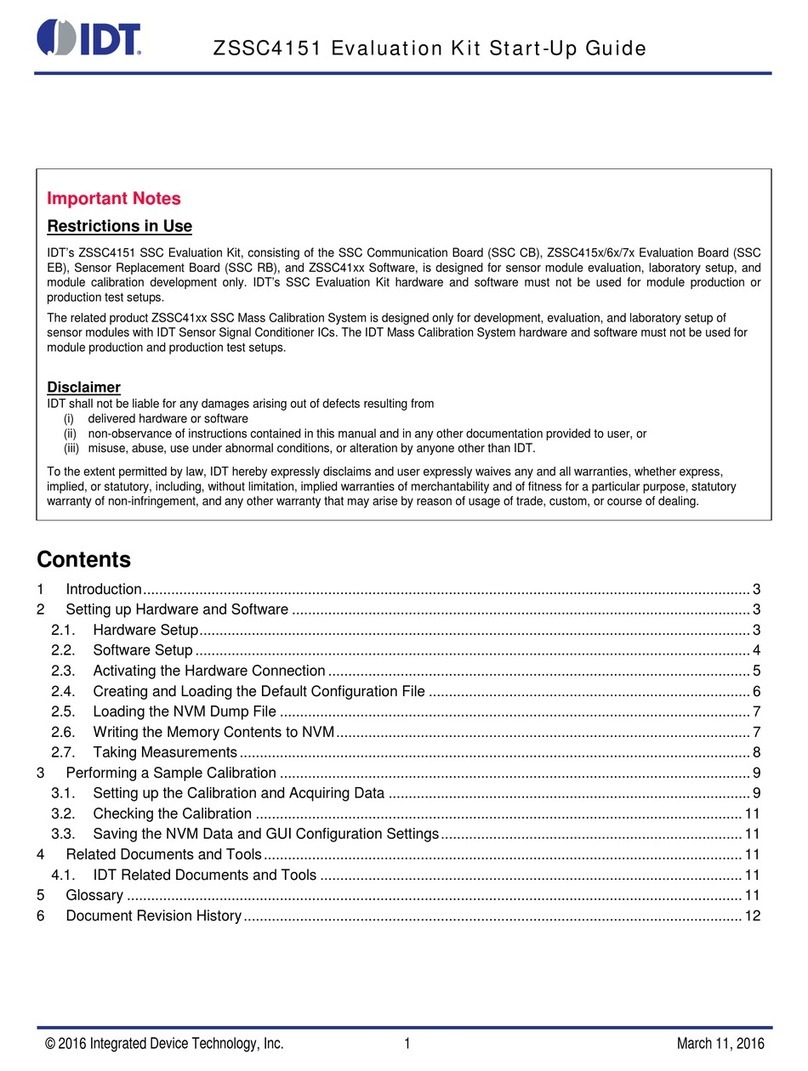
IDT
IDT ZSSC4151 User guide

IDT
IDT EB-LOGAN-23 User manual

IDT
IDT PhiClock 9FGV1001 User manual

IDT
IDT ZSSC4151 User manual
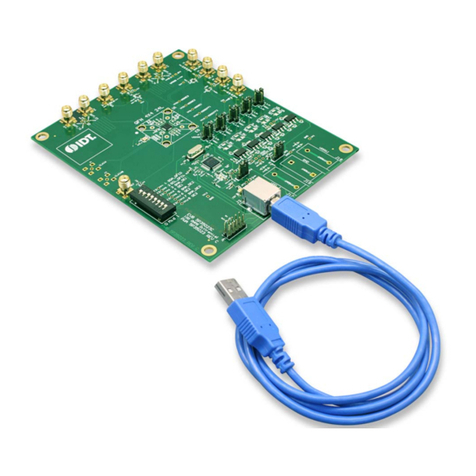
IDT
IDT VersaClock 3S User manual

IDT
IDT 8A34xxx 48QFN series User manual
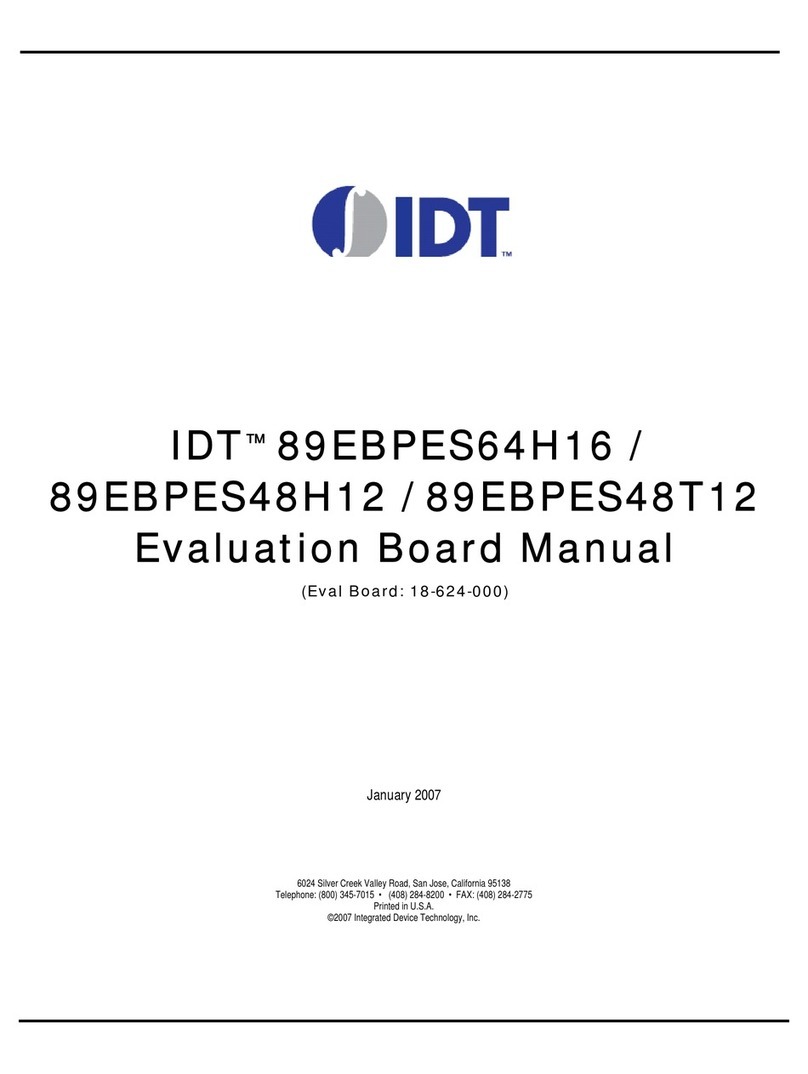
IDT
IDT 89EBPES48H12 User manual
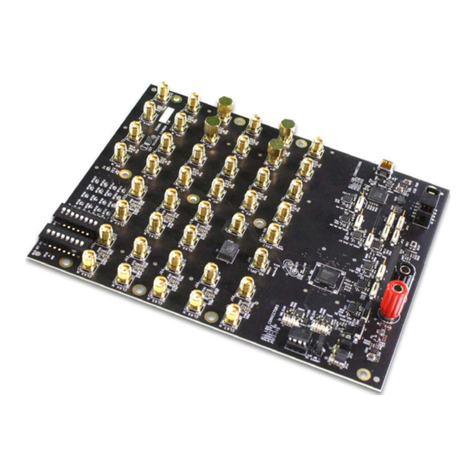
IDT
IDT 8A34 Series User manual
